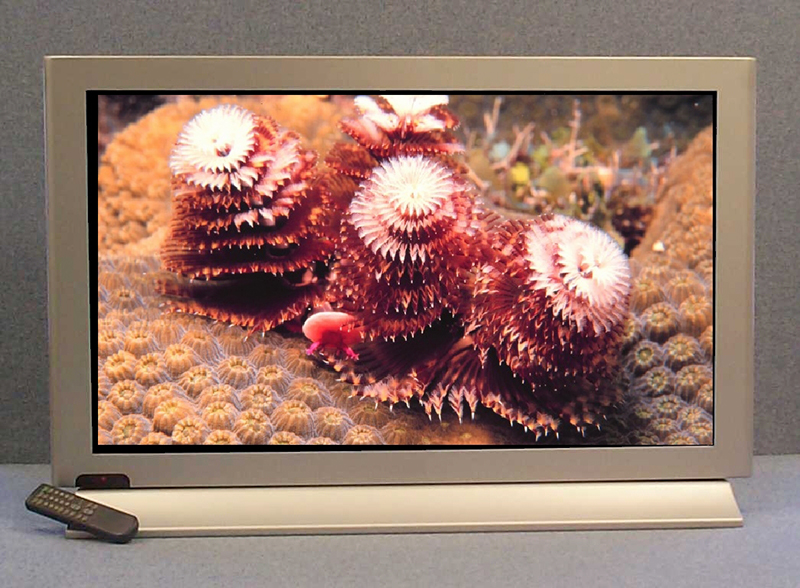
Microspheres in Plasma Display Panels
Originating Technology/NASA Contribution
NASA does things that have never been done before—sending spacecraft to other planets, sending people to the Moon, and exploring the limits of the universe. To accomplish these scientific missions, engineers at work within the Space Agency build machines and equipment that have never been made before—rockets that can send advanced instruments across the solar system, giant telescopes that watch the stars from space, and spacecraft that can keep astronauts safe from the perils of space flight. To do these never-before-done deeds with these never-before-made materials, NASA often needs to start at the basics and create its own textiles and materials. The engineers and materials specialists at the Space Agency are, therefore, among the best in the world.
It is not surprising then, that oftentimes, when industry engineers have difficulties with their designs or processes, they turn to NASA for assistance and NASA teams are happy to oblige.
Partnership
Filling small bubbles of molten glass with gasses is just as difficult as it sounds, but the technical staff at NASA is not known to shy away from a difficult task.
When Microsphere Systems, Inc. (MSI), of Ypsilanti, Michigan, and Imaging Systems Technology, Inc. (IST), of Toledo, Ohio, were trying to push the limits of plasma displays but were having difficulty with the designs, NASA’s Glenn Garrett Morgan Commercialization Initiative (GMCI) assembled key personnel at Glenn Research Center and Ohio State University for a brainstorming session to come up with a solution for the companies.
They needed a system that could produce hollow, glass micro-sized spheres (microspheres) that could be filled with a variety of gasses. But the extremely high temperature required to force the micro-sized glass bubbles to form at the tip of a metal nozzle resulted in severe discoloration of the microspheres. After countless experiments on various glass-metal combinations, they had turned to the GMCI for help.
NASA experts in advanced metals, ceramics, and glass concluded that a new design approach was necessary. The team determined that what was needed was a phosphate glass composition that would remain transparent, and they went to work on a solution.
Six weeks later, using the design tips from the NASA team, Tim Henderson, president of MSI, had designed a new system in which all surfaces in contact with the molten glass would be ceramic instead of metal. Meanwhile, IST was able to complete a Phase I Small Business Innovation Research (SBIR) grant supported by the National Science Foundation (NSF) and supply a potential customer with samples of the microspheres for evaluation as filler materials for high-performance insulations.
In 2002, MSI received a $35,000 GMCI “Commerciali-zation Assistance Award” to upgrade and implement its production system to evaluate customer and investor reactions to a new plasma display panel; and IST was able to continue to develop the flexible display technology using microspheres.
In addition to the Phase I SBIR, IST went on to receive NSF Phase II and Phase IIB grants, as well as a National Institute of Standards and Technology Advanced Technology Program grant for $2 million and two additional research grants from the State of Ohio, totaling nearly $800,000.
Product Outcome
Under the direction of its president, Carol Ann Wedding, IST specializes in microspheres for flat-panel displays and related devices—with a strong focus and capability in plasma display design, development, and analysis. The staff at IST can trace its roots back to the development of the very first plasma displays created; and microspheres are the key component for IST’s novel plasma displays, since they can be made into a variety of contours and shapes without distorting the image.
IST markets the microspheres as Plasma-spheres, tiny hollow spheres encapsulating an ionizable gas that glows when charged. The spheres, which can be applied to both flexible and rigid panels, form the basis of an addressable pixel element—a Plasma-sphere display. The display offers the same bright, full color as a conventional plasma display, but it is very rugged and can be a low-cost solution for large-area flexible displays.
These displays have commercial application in the markets of large venue displays, large conformable displays, and eventheaters.
The company continues to stay on the cutting edge of this field, thanks in part to the NASA partnership. It has worked on many designs, products, and services in the area of imaging and display technology, including product tear-downs, analysis and correction of false contour and motion artifacts, as well as development of custom test equipment. It has even designed a line of large-area touchscreens, including the world’s largest, which measures in at 32 by 8 feet.
In October 2005, IST received the prestigious “R&D 100 Award,” making it the third time that plasma display research teams led by the Wedding family have received this honor. In 1982, Donald K. Wedding with Dr. Donald R. Willis of Magnavox had received the award for the development of the world’s first 1-meter plasma panel. In 1990, Carol Ann Wedding had received the award for the development of the first video addressable color plasma display. The company received the R&D 100 award, which recognizes its cutting-edge technology as one of the most technologically significant products of the year, for its innovative work in flexible Plasma-sphere displays. That same year, IST was also awarded the “State of Ohio 2005 Emerging Technology Award.”
Plasma-sphere™ is a trademark of Imaging Systems Technology, Inc.

Conceptual drawing of a large-area, thin flat-panel display television in a home setting. Imaging Systems Technology, Inc., engineers were among the first to begin work in the field of developing plasma displays, and they are continuing to push the boundaries of this field.

Imaging Systems Technology, Inc., is leading the way in the areas of plasma design, development, and testing.













